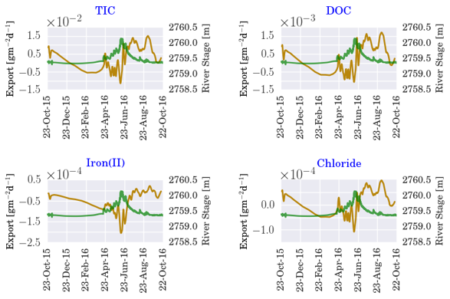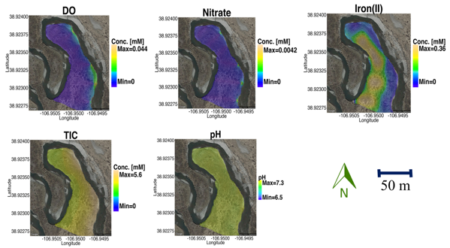Hyporheic exchange within the intra-meander region results in the interaction of nutrient-rich groundwater and oxygen-rich river water, which leads to the formation of distinct redox gradients. These redox gradients can significantly impact the export of metals and nutrients at the local, reach, and watershed scales. Further, transient hydrologic conditions, such as groundwater flow dynamics, river-stage fluctuations, and rainfall/snowmelt events, can impact redox processes in the hyporheic zone and ultimately the geochemical exports to the river thereby affecting river water quality. Here we have used high-resolution hydrodynamic assessments of the hyporheic zone combined with detailed pore-water sampling to focus on the hyporheic exchange at the meander scale for the purpose of quantifying the subsurface exports from a single meander to the river under transient hydrological conditions.
This study is a first of its kind that examines the influence of transient hydrological conditions on the hyporheic biogeochemistry using field observations. Simulation results demonstrated that intra-meander hyporheic zones display distinct anoxic and suboxic regions, suboxic regions being localized along sides of the meander bend. Permeability within the meander has a more significant impact on biogeochemical zonation compared to the reaction pathways for transient hydrologic conditions. Here we have also demonstrated the outsized implications of micro-topographic features such as gullies on redox processes using the high-resolution LiDar data.

Figure 2. Net cumulative geochemical export of TIC, DOC, and iron(II) from a single meander. River-stage is shown in green on the right y-axis, whereas the net export is shown in golden color on the left y-axis.
Summary
Hyporheic zones perform important ecological functions by linking terrestrial and aquatic systems within watersheds. Hyporheic zones can act as a source or sink for various metals and nutrients. Transient hydrologic conditions alter redox conditions within an intra-meander hyporheic zone thus affecting the behavior of redox-sensitive species. Here we investigated how transient hydrological conditions control the lateral redox zonation within an intra-meander region of the East River and examined the contribution of a single meander on subsurface exports of carbon, iron, and other geochemical species to the river. The simulation results demonstrated that the reductive potential of the lateral redox zonation was controlled by groundwater velocities resulting from river-stage fluctuations, with low-water conditions promoting reducing conditions. The sensitivity analysis results showed that permeability had a more significant impact on biogeochemical zonation compared to the reaction pathways under transient hydrologic conditions. The simulation results further indicated that the meander acted as a sink for organic and inorganic carbon as well as iron during the extended baseflow and high-water conditions; however, these geochemical species were released into the river during the falling limb of the hydrograph. This study demonstrates the importance of including hydrologic transients, using a modern reactive transport approach, to quantify exports within the intra-meander hyporheic zone at the riverine scale.
Citation
Dwivedi, D., C.I. Steefel, B. Arora, M. Newcomer, J.D. Moulton, B. Dafflon, B. Faybishenko, P. Fox, P. Nico, N. Spycher, R. Carroll, and K.H. Williams (2018), Geochemical Exports to River from the Intra-Meander Hyporheic Zone under Transient Hydrologic Conditions: East River Mountainous Watershed, Colorado, Water Resources Research, 10.1029/2018WR023377.

